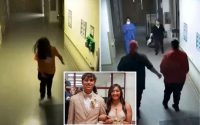Smithsonian returns woman’s brain 90 years after her death
The Smithsonian Institution has finally returned a dead teenage girl’s brain to her surviving relatives — 90 years after it was reportedly taken without their knowledge for controversial race research.
When Mary Sara, an 18-year-old indigenous Mari girl, died of tuberculosis in Seattle in 1933, her doctor mailed her brain to a Smithsonian anthropologist for his “racial brain collection,” according to the Washington Post.
There is no record that her family gave consent, and they only discovered it was missing when the DC paper revealed at least 30,700 human remains were being held in a Maryland storage facility for the Museum of Natural History.
The family petitioned to get back the brain — which an employee flew from DC to Seattle on Aug. 28.
The brain, immersed in preservatives within a sealed container, was then transferred to a cushioned wooden box and buried with the rest of her the next day.
“It’s a great burden lifted off,” her cousin Martha Sara Jack told the Washington Post following the ceremony at Evergreen Washelli cemetery. “There’s no loose end on this part now.”
Sara’s brain had been sent to Ales Hrdlicka, the then-curator of the Smithsonian’s division of physical anthropology, who was known to believe in white supremacy, the outlet said.


Smithsonian Secretary Lonnie Bunch III recently called such work the institution’s “darkest history.”
“It was abhorrent and dehumanizing work, and it was carried out under the Smithsonian’s name,” he wrote last month.
“I condemn these past actions and apologize for the pain caused by Hrdlicka and others at the institution who acted unethically in the name of science, regardless of the era in which their actions occurred.”
Sara was originally from Alaska, but traveled to Washington state in 1933 to support her mom, who had cataract surgery there. She had intended to return home and marry her childhood sweetheart, but became sick with tuberculosis, dying in a sanitarium where she spent her 18th birthday.

Her mother’s eye surgeon, Dr. Charles Firestone, then offered the dead teen’s brain to Hrdlicka — who said he was only interested if Sara was “full-blood,” meaning both her parents were Sami, an indigenous people from Norway, Sweden and Finland, the Washington Post said.
When Firestone responded that she was, he shipped the brain to DC, where Hrdlicka would keep it.
“Without the knowledge or consent of her family, Dr. Firestone maliciously desecrated Mary’s young body,” Jack, her cousin, said at the burial.
“Now, 90 years later, Mary’s body will be made whole and laid to rest until the Resurrection.”

The National Natural History Museum said it was honored to return Sara’s brain to her family.
“Our museum community remains committed to addressing the historical legacy bestowed upon us and will continue to work with descendants and descendant communities to return or appropriately honor the individuals now under our care,” said spokesman Jim Wood.
Sara’s brain was the fifth to be returned to families or tribes, with another 254 remaining, the paper said.
The other four brains were repatriated to Native American families or communities under federal law, which requires the Smithsonian to notify Native American, Alaska Native and Native Hawaiian communities about the remains in its possession.

The last brain to be returned was sent to a Tlingit family in Sitka, Alaska, in 2007, the report said. Some 6,300 sets of remains have also been returned over the last three decades.
Last year, the Smithsonian adopted a policy that formally authorized all of its museums to return items or remains in its collections that were obtained without consent.
But officials told the Washington Post they were primarily focused on returning the Native American remains, leaving about 15,000 sets of remains from more than 80 countries in limbo.
By April, Bunch issued a public apology, and announced the creation of a task force to determine the next steps for the human remains that are still in the institution’s custody.

He said it was in talks with the government of the Philippines to determine what to do with the remains of Filipinos that had been part of the collection.
The National Museum of the Philippines said it “accepts and supports this effort of the Smithsonian to do the right thing and facilitate the return of these Filipino remains home as a way of rectifying this unfortunate situation.”
Rachel Twitchell-Justiss, a distant cousin of Sara’s, said she hopes the return of her relative’s brain could encourage the Smithsonian to move faster in repatriating the remains of other families and communities.
“I hope the museum makes great strides to fulfill their promises to do better,” she said. “If they can do that in Mary’s honor, then all the better.”


